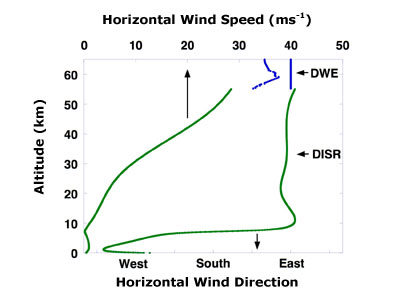
Titan News 2005 and 2004
December 3, 2005: The high complexity of Titan's atmosphere and meteorology revealed in the synthesis of Huygens's results
Almost one year after the successful landing of the Huygens probe on Titan's soil, Titan is under the spotlight with a series of papers published in the Journal "Nature" and available on line on 30 November 2005. An ESA press conference in Paris has also been held to present the results of the mission.
During the plunge of the parachuted Huygens probe into Titan's atmosphere which lasted 2 hours and 28 minutes, the instruments recorded a large amount of information such as the density and pressure profiles of the atmosphere, the temperatures, the nature of the aerosols, the structure of the atmosphere, the speed of the winds, their direction, electrical discharges events. The famous orange haze is present all the way down to the surface. However, it was transparent enough for good images of the surface to be obtained below 40 km altitude.
Several instruments onboard the probe collected data on chemical and physical properties of the atmosphere: the Gas Chromatograph Mass Spectrometer ( GCMS ), the Aerosol Collector and Pyrolyser ( ACP ) and the Huygens Atmospheric Structure Instrument ( HASI ), the DISR ( Descent Imager Spectral Radiometer ) and the DWE ( Doppler Wind Experiment ).
The winds appear to blow predominantly in the direction of Titan's rotation, west to east winds, with speeds up to 450 km / h above an altitude of 120 km. As the altitude decreased, the wind speed diminished, from around 25 m/s ( 90 km / h ) to a walking speed at the surface. The figure below shows that the wind speed slightly increases between 10 km altitude and 0 km to drop again to a walking speed at the level of the surface. An unexpected layer of high wind-shear was encountered between altitudes of 100 and 60 km. Another particularity on this figure is the change in the direction of the winds close to the surface. At around 7 kilometers altitude ( 4 miles ), wind speed dropped to less than 3 km/h ( less than 2 mph ) and the winds changed direction: this may be a convective region where local winds disconnect from Titan's main jet-streams.

The Huygens Atmospheric Structure Instrument ( HASI ) was designed to measure temperatures, density profiles, electrical conductivity and surface structure. It enabled scientists to identify three major phenomena: strong turbulence in the upper atmosphere, a second ionospheric layer and probably lightning. In the upper atmosphere, temperature and density are both higher than expected and strong wave-like variations of 10-20 K can be observed with a mean temperature of 170 K.
Titan's atmosphere appears to have many different layers. Models of Titan's ionosphere predicted that galactic cosmic rays would produce an ionospheric layer with a maximum concentration of electrons between 70 and 90 km altitude. But, HASI surprised the Huygens team by finding a second lower ionospheric layer between 140 km and 40 km, with electrical conductivity peaking near 60 km. During the descent, HASI also detected several electrical field impulse events,which might be the sign of lightning.
The figure below, proposed by the European Space Agency, reveals notably the evolution of temperatures and pressure as a function of altitude. For instance, at 100 km altitude, the pressure measured by the probe represents 0.009 bars ( 9 hPa ). At this altitude, the temperature is a little higher than 140 K ( -133.15°C or -207.67°F ).The figure shows that during the descent phase, the temperatures decrease until around 50 km altitude with temperatures a little higher than 70 K ( -203.15°C or -333.67°F ) and then go up up to the Titan's landing site where the environmental temperature is accurately measured at 93.65 K ( -179.5°C or -291.1°F ). The atmospheric pressure at the surface is measured at 1467 hPa which is higher than the mean atmospheric pressure on Earth ( 1014 hPa ).
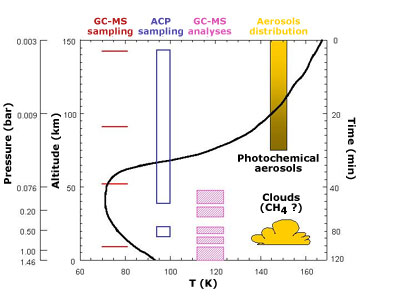
The Aerosol Collector and Pyrolyser ( ACP ) and the Gas Chromatograph Mass Spectrometer ( GCMS ) provided the first in situ chemical data on Titan's atmosphere, including aerosols, chemical composition and isotopes. The GCMS measured chemical composition and isotope abundances from 140 km altitude to the surface. It confirmed the results gathered by the Voyager probe: Titan's atmosphere is mostly composed of molecular nitrogen and methane. The concentration of methane reaches 5% of its composition compared to around 94% for nitrogen. The orange haze is primarily methane. One of the main goals of the mission is to answer the following question: What is the origin of molecular nitrogen and methane? Is it linked to geologic processes such as cryovolcanism, living organisms or degradations of organic debris?
The GCMS provides key data to answer this question. It made some isotopic ratio measurements. The carbon isotope ratio ( 12C / 13C ) measured in methane suggests a continuous or periodic replenishment of methane in the atmosphere but no sign of active biological systems. Each 13C atom has an extra neutron in its nucleus, making them slightly heavier than 12C atoms and the GCMS can distinguish between methane with 12C and methane with 13C. Living organisms have a preference for carbon-12. So, carbon-containing molecules, such as methane, that are associated with life on Earth get enriched in 12-C. The ratio of 12C to 13C is a good indicator of life. Nevertheless, the Huygens team did not see 12C enrichment in the methane on Titan. Dr Hassa Niemann of Goddard Space Flight Center pointed out: "We have determined that Titan's methane is not of biological origin , so it must be replenished by geologic processes on Titan, perhaps venting from a supply in the interior that could have been trapped there as the moon formed".
The nitrogen isotope ratio ( 14N/15N ) implies that the early atmosphere of Titan was five times denser than it is now, and hence lost nitrogen to space. Argon 36, a noble gas, was detected for the first time, but not Xenon or Krypton. If the spectrometer had detected the primordial noble gases, they would have signaled that the atmosphere on Titan today is the same as acquired at the time of Titan's formation. The low abundance of Argon suggests that the atmosphere was condensed or captured as ammonia, instead of nitrogen, which is believed to be the same way nitrogen formed on Earth. Ammonia was probably delivered by icy planetesimals during the moon's formation process and eventually turned into nitrogen by interaction with sunlight.
After this two and a half hour journey through Titan's gas blanket, the probe landed successfully in a flat area covered with pebble-like stones, around 15 cm in diameter. It seems that the probe broke an "ice pebble" in the touchdown and then slumped into a sandy surface possibly dampened by liquid methane. Penetrometry and accelerometry measurements indicate that Huygens landed on a relatively soft surface resembling wet clay . The probe had penetrated around 10 cm into surface. The probe's vertical velocity just before touchdown was determined with high precision as 4.6 m/s ( 16.56 km/h ) and the landing location had an undulating topography of around 1 metre over an area of 1000 sq.metres. The Huygens module landed in a dark area likely dominated by fluvial and marine processes. The images of Titan's landscape before landing show that the dark area comprises streaks, either related to fluvial activity or wind borne activity.
After impact, the GCMS recorded a 40 percent increase in the number of methane molecules measured as shown in the graph below, and this level remained for about 50 minutes after touchdown.
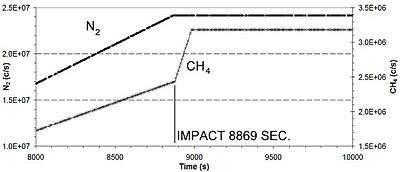
The surface and the near surface atmosphere were studied by the DISR ( Descent Imager Spectral Radiometer ) just before touchdown: at 700 meters altitude ( around 0.45 mile ), it turned on a landing lamp so spectrometers could analyse light reflected. The spectrometers measured five percent methane in Titan's mostly nitrogen atmosphere at 20 meters ( 66 feet ) altitude. DISR scientists deduced: that's three times more methane than in Titan's stratosphere and confirms that methane is condensing near Titan's surface. Titan's surface reflected no more than 15 percent to 20 percent at infrared light wavelengths. Light reflected revealed there are organic materials and water ice but also water ice laced with an unknown constituent.
Argon 40 was identified at the surface which is a sign of internal geological activity because on Earth, argon 40 is produced in volcanic rocks by the radioactive decay of potassium 40. The GCMS also showed that the surface is rich in organic compounds, methane but also compounds not seen in the atmosphere, cyanogen and ethane.The graph below shows the surface spectrum of the surface of Titan.
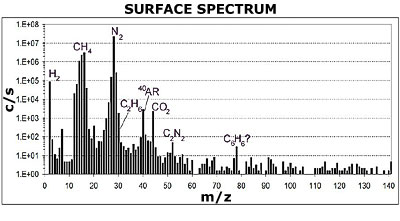
The diagram below indicating what might be the internal structure of Titan illustrates the mechanisms by which Argon 40 is produced and expelled towards the surface.
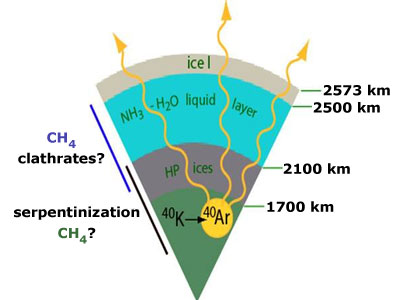
ACP performed direct measurements of the chemical composition of the aerosol particles. The analysis of the products was obtained via pyrolysis ( chemical decomposition of organic materials by heating ) of aerosols at 600°C and ammonia ( not present as a gas in the atmosphere) and hydrogen cyanide were the first molecules identified.
The graph below shows that light intensity measured by the visible spectrometer looking upward in the direction opposite to the Sun increases as altitude decreases. This change in brightness is due to the increase in the number of aerosol particles, scattering the sunlight, above the probe as it descends through the atmosphere.
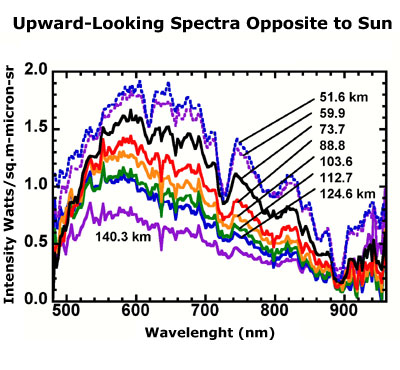
One of the major problems Cassini / Huygens scientists had to solve is the exact location of Huygens probe landing site and they finally managed to accurately identify it. In terms of Titan longitude and latitude, the Huygens module landed around 5 kilometers ( 1.4 miles ) of 192.4 degrees west longitude ( or 167.6 degrees east longitude ) and minus 10.2 degrees south latitude, Bashar Rizk of the University of Arizona Lunar and Planetary Laboratory ( LPL ) and Steven Wall of NASA's Jet Propulsion Laboratory pointed out. That's only 7 kilometers ( 4 miles ) away from where Cassini / Huygens scientists predicted the probe would touchdown, they added.
The panoramic mosaic below shows the landing site of the Huygens probe from an altitude of around 15 km. The circle indicates the outline of the low-altitude panorama view from 1.2 km below this image.
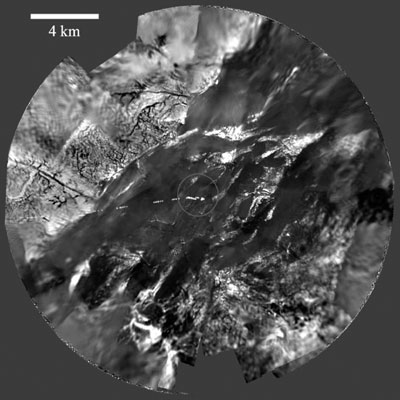
The panoramic mosaic below reveals the landing site marked with an "X" near the continuation of one of a dozen channels that cross a ridge near the centre of the image..
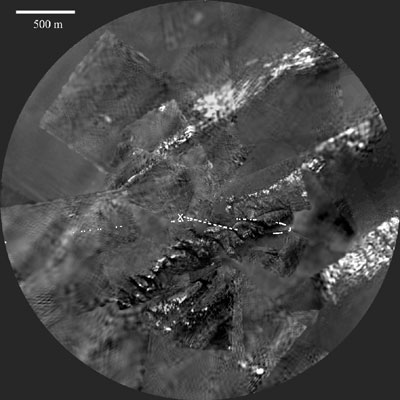
- This article is based on several articles and papers published in the ESA website, the University of Arizona website, the University of Michigan website and other sources. All the images, graphs and diagrams are proposed by ESA and NASA. To get more information on that news, go to: http://www.esa.int/SPECIALS/Results_from_Mars_Express_and_Huygens/SEMTFSULWFE_0.html , http://www.esa.int/SPECIALS/Results_from_Mars_Express_and_Huygens/SEMLKRULWFE_0.html , http://www.esa.int/SPECIALS/Results_from_Mars_Express_and_Huygens/SEM23TULWFE_1.html , http://www.esa.int/SPECIALS/Results_from_Mars_Express_and_Huygens/SEM80TULWFE_0.html , http://www.esa.int/SPECIALS/Results_from_Mars_Express_and_Huygens/SEMK1TULWFE_0.html , http://www.spaceflightnow.com/news/n0511/30huygenslanding , http://www.spaceflightnow.com/news/n0511/30titanearth , http://www.spaceflightnow.com/news/n0511/30methane , http://www.astrobio.net/news/modules.php?op=modload&name=News&file=article&sid=1790&mode=thread&order=0&thold=0
November 5, 2005: The latest radar images reveal a pleiade of dark linear streaks and possibly a methane sea
The Cassini spacecraft completed its ninth Titan flyby on Oct.28, 2005. It was the fourth time that the Cassini's synthetic aperture radar took images of Titan's surface. The latest radar images were captured at a distance of around 1300 kilometers ( 800 miles ). Those high resolution orbital data were focused on the Huygens landing site. They don't show, clearly, an ocean of hydrocarbon molecules as we might have expected. The radar images show some similarities with the flyby of February.15, 2005: one can observe a multitude of dark, linear and parallel streaks extending over great distances ( over 100 km long ). Those dark streaks, which seem to be common on Titan, had been nicknamed "cat scratches" during the radar pass of February 2005. Most scientists suggest it might be the separation of ice dunes ( hydrocarbon molecules, mixtures of water or ammonia...) driven by winds blowing from west to east. The bright features which appear in the radar images are generally stretched from the left to the right as if there was a current influencing their shape. Those bright patches, in most cases, likely appear to be ridges deriving from tectonic activity and deformation from Titan's icy crust. One can note that there is often a correlation between the direction of what appears to be ridges and the direction of the dark streaks. On the basis of that observation, one could say that the ridges are generated by tectonic movements and change shape under the action of winds unless all those structures are entirely engendered by internal movements.
The nature and the origin of the dark linear streaks is not completely understood. Most scientists envisage, indeed, that those " cat scratches" reveal dunes driven by the strength of the winds as we encounter it on Earth. But one can also suggest that those streaks are the outcome of a subsurface ocean with eastward currents that would create fractures or grooves in the icy crust of Titan. Hence, that would also explain, for instance, why the dark streaks have the same direction as most of the ridges in their environment. And methane in Titan's atmosphere, which seems to be continuously replenished by this compound, might come from those grooves or streaks. Who knows?
The latest radar images reveal, moreover, a very dark area which might be the sign of a liquid area.There is apparently a pool, roughly oval, and 20 km wide. Dark branching Channels, around 2 km wide are connected to this dark oval region and extend over 40 km. Those very dark patterns are located in a relatively bright area. This dark area reminds us of the very dark patch spotted in the south polar region, the cloudiest area at the moment ( summer hemisphere ).
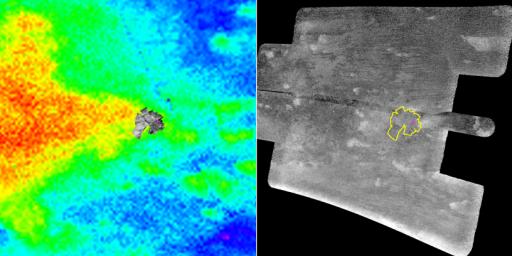
On the left, in color, is a composite of the imaging camera and infrared data ( red areas are brighter and blue darker, as seen in infrared ). On the right is the synthetic aperture radar image. The Huygens descent images are shown inset on the left image and outlined in yellow on the right. The magenta cross in both images shows the best estimate of the actual Huygens landing site. Image Source: NASA, JPL.
- To get more information on that news, go to: http://saturn.jpl.nasa.gov
October 22, 2005: The origin of midlatitude clouds on Titan: methane cycle versus internal sources
Titan's atmosphere gathers high concentrations of methane ( up to 5% of the atmosphere's composition ) that can form clouds. This meteorology involving methane is particularly intriguing because methane is constantly destroyed by ultraviolet rays over a period of about 10 million years in a process called photolysis. It should have disappeared billions of years ago. Now, perhaps that geologic phenomena continuously replenish the atmosphere with methane. That's what tend to show new observations led by Henry G. Roe, planetary astronomer, a postdoctoral researcher , Michael E. Brown, professor of planetary science at the California Institute of Technology, their colleagues at Caltech and the Observatory in Hawaii. Images reveal distinctive clouds that sporadically appear in the middle latitudes of the moon's southern hemisphere. Those temporary clouds might not be linked to a methane cycle with liquid methane evaporating from the surface, then forming clouds. It might rather be related to internal sources via cracks, cryovolcanoes, geysers or hot springs. On that point, several signs of cryovolcanoes have been spotted up to now.
Henry G. Roe points out:" This is the first strong evidence for currently active methane release from the surface." Michael E. Brown adds:" For a long time we've wondered why there is methane in the atmosphere of Titan at all, and the answer is that it spews out of the surface. And what is tremendously exciting is that we can see it, from Earth; we see these big clouds coming from above these methane vents, or methane volcanoes. Everyone had thought that must have been the answer, but until now, no one had found the spewing gun."
This breakthrough was made possible with new techniques: the images were captured during the past two years by adaptive optics systems on the 10-meter telescope at the W. M. Keck Observatory on Mauna Kea in Hawaii and the neighboring 8-meter telescope at the Gemini North Observatory. Adaptive optics has the property to remove the blurring of atmospheric turbulence, creating images as sharp as would be obtained from space-based telescopes.
"At both telescopes, the science data were collected from only about a half an hour of images taken over many nights. Only this unusual quick look scheduling could have produced these unique results. At most telescopes, the whole night is given to a single observer, which could not have produced this science."
Titan was observed on 82 nights by both telescopes. On 15 nights, the images showed distinctive bright clouds- two dozen in all-at midlatitudes in the southern hemisphere. The clouds usually popped up quickly, and generally had disappeared by the next day. Roe points out:" We have several observations where on one night, we don't see a cloud, the next night we do, and the following night it is gone." Some of the clouds were 2000 km long. They evolve somewhere between 10 km and 35 km above the surface, within Titan's troposphere. They were all located within a relatively narrow band at around 40 degrees south latitude, and most were clustered tightly near 350 degrees west longitude. Hence, the researchers noted that the clouds appear sporadically in specific places suggesting that they are not arising from the regular convective overturn of the atmosphere due to its heating by the sun ( which produces the cloud cover across the moon's southern pole ). A geologic feature must engender those ephemeral cloud formations.
Henry G. Roe argues:" If these clouds were due only to the global wind pattern, what we call general circulation, there's no reason the clouds should be linked to a single longitude. They'd be found in a band around the entire moon."
So, how to interpret those non permanent stationary clouds? Several options have been advanced: first, the clouds might appear in areas where the surface composition has a relatively low reflectivity or albedo, hence, stimulating the evaporation process of methane. One can imagine, notably, a sea of methane which would have a high absorption of solar energy. But no clear indications of methane seas have been identified at midlatitudes. In a region where the albedo is low, the air above those warmer spots would be heated, then rise and form convective clouds, much like thunderstorms on a summer's day on Earth. The authors of the study eliminate this possibility because they detected no differences in the brightness of the surface at 40 degrees south latitude. They also rule out the hypothesis of elevated terrain or mountain that would conduct winds upward. It's very unlikely because the clouds should always appear in the identical locations. Henry G. Roe specifies:" We see the clouds regularly appear in the same geographic region, but not always in the exact same location."
The most likely explanation for those unfamiliar clouds, according to the researchers, is the presence of internal sources continuously injecting methane into Titan's atmosphere. Roe and his colleagues point out that they don't have any strong clue about the nature of the geologic features engendering those clouds. Nevertheless, they suggest cracks or icy cryovolcanoes potentially responsible for those blankets of methane vapour. Henry G. Roe adds: We think there are numerous sources all over the surface, of varying size, but most below the size that we could see with our instruments." One large feature near 350 degrees west longitude is probably producing the cluster of clouds that forms in that region, while also humidifying the band at 40 degrees latitude.
UA associate professor Caitlin Griffith, Paulo Penteado and Robert Kursinski of UA's Lunar and Planetary Lab also studied those localized cloud formation systems over the temperate latitudes by using images from Cassini's visual and infrared mapping spectrometer ( VIMS ) onboard the Cassini spacecraft. They obtained a 3-D view of the cloud and a six-frame movie that shows how it evolves over three hours. Caitlin Griffith pointed out:" We detected not one region, but many regions of cloud formation. Each long cloud consists of a number of vigorous storms where clouds rise to 40 kilometers altitude ( 25 miles ) in a couple of hours and dissipate in the next half hour. The rate of cloud ascent and dissipation suggests that we are witnessing the formation of convective clouds, likely similar to thunderstorms, that disappear through rainfall. Over the next several hours we see the clouds form long tails, indicating that strong westerly winds stretch out the clouds and carry the particles downwind a thousand kilometers ( more than 600 miles ). This detailed look into the structure of these clouds reveals that the clouds evolve from a number of small active cloud formation centers lined up like an uneven string of beads long 40 degrees south latitude. These localized storms cause a healthy rain, and very long clouds, once the wind has stretched them out."
Caitlin Griffith notes that it's unlikely that the origin of these midlatitude clouds ( at 40 degrees south latitude ) is related to cryovolcanoes or tidal forces generated by Saturn and its other satellites. She points out, moreover, that there are some analogies with Earth's meteorology. The air from the pole doesn't mix with the air rising at midlatitudes. On Earth, clouds form in a band around the equator and rain on the Caribbean islands. On Titan, the global circulation system would be roughly similar: the rising air at midlatitudes would prevent air from the south polar region from mixing with the rest of the moon's atmosphere, causing smog to build up and form a cap over the pole, as Griffith argues.
Caitlin Griffith summarizes Titan's meteorology with the following statement:" If you walked past Titan's minus-40-degree-latitude line, you might be showered with liquid natural gas. If you decided to visit Titan's south pole, you might encoutner a storm the size of a hurricane which also consists of methane, more commonly known as natural gas.Otherwise, don't expect clouds on Titan."
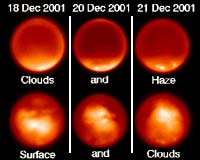
The images of Titan above which were taken from ground based telescopes in December 2001 reveal cloud formations on Titan.
- To get more information on that news, go to: http://www.spacedaily.com/news/saturn-titan-05zd.html or http://uanews.org/cgi-bin/WebObjects/UANews.woa/10/wa/SciDetails?ArticleID=11870
October 8, 2005: Titan's mysterious bright red spot might reveal an exotic surface feature
The infrared images taken by the "Visual and Infrared Mapping Spectrometer" onboard the Cassini spacecraft reveal a bright red spot that outshines everything else. This 300-mile-wide ( around 480 km ) patch is located in the southeast of the continent-sized region called Xanadu. The feature is spectacularly bright at 5-micron wavelengths. The combination of VIMS and ISS images of this bright red patch shows a significant contrast between this oval area and the surrounding landscape.
According to University of Arizona scientists and the Cassini Imaging Team, it might not be linked to a mountain, a cloud or a geologically active hot spot. Jason W. Barnes, a postdoctoral researcher at UA's Lunar and Planetary Lab, points out:"We must be looking at a difference in surface composition....That's exciting because this is the first evidence that says not all of the bright areas on Titan are the same. Now we have to figure out what those differences are, what might have caused them."
The bright spot is so reflective that it can be detected with Cassini's visible-wavelength imaging cameras which photographed the region in December 2004 and February 2005 and revealed a bright arc-shaped feature approximately the same size.
Is the bright red patch a hot spot, such as a geologically active ice volcano? It's unlikely because Cassini's radar instrument, operating in the "passive" mode that is sensitive to microwaves emitted from a planetary surface, saw no temperature difference between the bright spot and surrounding region.
Is the bright red spot an elevated terrain or a mountain? It's also unlikely because Cassini microwave radiometry failed to detect a temperature drop that would show up if some two-mile high mountain rose from Titan's surface.
Is the bright red spot a cloud? If it is the case, it hasn't moved or changed shape for three years, according to ground-based observations made at the Keck Telescope and with Cassini's visual and infrared mapping spectrometer during five different flybys. In other words, if it is a cloud, it would be a stationary persistent ground fog as noted Jason W.Barnes. He adds:"The bright spot must be a patch of surface with a composition different from anything we've seen yet. Titan's surface is primarily composed of ice. It could be that something is contaminating the ice here, but what this might be is not clear."
The high reflectivity of this large area suggests that it must be some kind of ice. But if other regions are mostly made up of ice, why is this patch more reflective? Perhaps that the ice in this stunning place is purer, cleaner. And why would it be cleaner? It is tempting to advance that this bright patch is a giant ice-pack, a giant ice block evolving on a liquid area as proposes Marc Lafferre. What might be the nature of this ice? It seems that the environmental temperature is too high for it to be pure methane ice. It might rather be a mixture of water, ammonia and hydrocarbon compounds ( methane, ethane, acetylene, propane...). Then, one has to figure out what the nature of the sea beneath the giant ice block could be. It would undoubtedly be liquid ethane or liquid methane.
Another hypothesis to explain the nature of this bright red spot is that it is related to a large impact crater. The meteor would have dug very deep into Titan's crust unveiling another type of geologic layer, present at subsurface levels elsewhere.
If the impact is recent, probably that the soil is purer in this area, with less dust, making it more reflective. And the nature of the soil wouldn't be fundamentally different from the soil in other places.
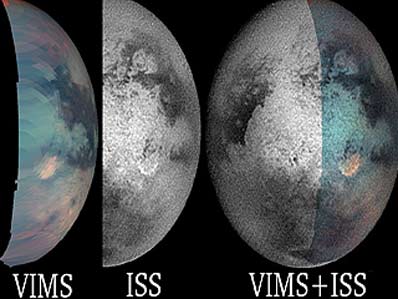 |
The images above, presented by University of Arizona scientists and Cassini Imaging Team members, clearly reveal the bright red spot, which lies south east of the Xanadu region.The image combining VIMS data and ISS data shows a clear contrast between this landscape feature and the surrounding region.
- To get more information on that news and Titan's related subjects, go to: http://uanews.org/cgi-bin/WebObjects/UANews.woa/10/wa/SRStoryDetails?ArticleID=11813 or http://www.spaceflightnow.com/news/n0510/06titan
September 24, 2005: New radar images reveal a shoreline and channels
The Titan flyby of Sept.7, 2005 allowed the Cassini spacecraft to scan key places in the southern hemisphere of the moon. The radar images are breathtaking. One can observe astonishing landscape features such as a shoreline and networks of channels. There is, indeed, a clear boundary between a bright, rough region and a dark, smooth region. The bright area is cut by channels. It seems that the dark region is flat, uniform and wet while the bright area is dominated by hills and high terrain comprising long and deep rivers.
Steve Wall, radar deputy team leader from NASA's Jet Propulsion Laboratory, Pasadena, California, said :"We've been looking for evidence of oceans or seas on Titan for some time. This radar data is among the most telling evidence so far for a shoreline". Regarding the dark area, he pointed out: " This is the area where liquid or a wet surface has most likely been present, now or in the recent past...Titan probably has episodic periods of rainfall or massive seepages of liquid from the ground."
Bright patches clearly appear in the dark area. It might be islands, hills or elevated terrain which have not been submerged by the mysterious fluid. The boundary between the bright area and the dark area has irregular shapes with bay-like features which contributes to the idea that this boundary is a coast or a shoreline.
Dr.Ellen Stofan, Cassini associate radar team member from Proxemy Research, Laytonsville, Md notes:" We also see a network of channels that run across the bright terrain, indicating that fluids, probably liquid hydrocarbons, have flowed across this region".
The origin of the formation of these networks of channels is uncertain. It might be linked to internal sources ( cryovolcanism, geysers, tidal forces...) or meteorology ( rainfall ). Two kinds of channels have been identified in these radar images. Some channels are long and deep, with angular patterns and few tributaries, suggesting that fluids flow over great distances. Others form a denser network with a branching structure suggesting rainfall.
Dr. Larry Soderblom with the U.S.Geological Survey in Flagstaff, Arizona, indicated:" It looks as though fluid flowed in these channels, cutting deeply into the icy crust of Titan. Some of the channels extend over 100 kilometers ( 60 miles ). Some of them may have been fed by springs, while others are more complicated networks that were likely filled by rainfall".
The Titan flyby of Sept.7, 2005 was the eighth out of 45 flybys planned in the nominal four-year tour. The next radar images will come on Oct.26, 2005 when the team will focus on the Huygens probe landing site close to the equator.
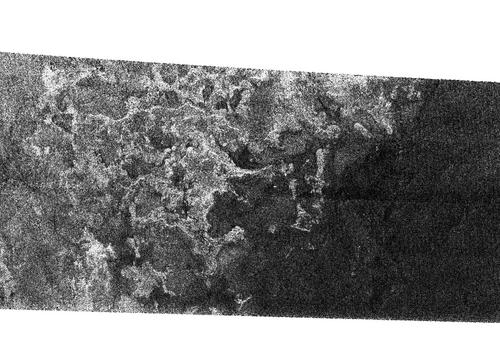
The radar image, above, was acquired by the Cassini spacecraft on Sept.7, 2005. The area is located in the southern hemisphere. There is a clear boundary, probably a shoreline, between a bright region, mostly composed of hills, elevated terrain and river-like structures, and a dark flat area, likely wet.
- To get further information on that news, go to: http://www.spaceflightnow.com/cassini/050916titanshoreline.html
September 17, 2005: Life on Titan, a reality?
Titan, the fifth largest terrestrial body in the Solar System, was long believed to be an "Ocean World". The Voyager probe revealed, in the late 70's, that Titan's atmosphere was similar to the atmosphere of the early Earth, 4 billion years ago, composed primarily of nitrogen and relatively abundant organic molecules such as methane, ethane or acetylene. The Voyager probe was not able to unveil the surface of this enigmatic moon because of a completely opaque atmosphere.
Under those circumstances, planetologists realized that two key elements were put together to make a methane ocean possible on this satellite: first, Titan's atmosphere contains methane and other hydrocarbon molecules, in a proportion of around 5%. And second, the amount of energy received from the Sun is about 15 w / m² / s² which corresponds to surface temperatures for which methane and ethane appear in their liquid form (-180°C or -292°F).
Yet , the Cassini-Huygens mission, arriving at Titan, in July 2004, revealed that Titan was not an "Ocean World" thanks, notably, to the Huygens spacecraft, the VIMS ( Visual and Infrared Mapping Spectrometer ) and the Radar Mapper onboard the Cassini orbiter.Titan was rather a dry world dominated by cryovolcanism and a meteorology with a very slow methane cycle.The Huygens probe spotted grooves, channels, rivers or fractures on low altitude hills ( about 150 m high ) ending their way in a dark flat area. The Cassini spacecraft identified many other key elements such as what appears to be a cryovolcano, rare clouds at mid latitudes, large cloud formations in the south pole and also what might be a lake, hundreds of km wide in the same area where it is currently summer.
On the basis of those observations, is life possible on Titan? The hypothesis for Titanian lifeforms has been developed September 8 at the Division for Planetary Sciences 2005 Meeting in Cambridge, United Kingdom. David H.Grinspoon, Mark A.Bullock, John R.Spencer ( SouthWest Research Institute ) and D.Schulze-Makuch ( Washington State University ) performed the study with funding from the NASA Exobiology Program using published results from the Cassini-Huygens mission. They note that several key requirements for life now appear to be present on Titan, including liquid reservoirs, organic molecules and ample energy sources. Methane clouds suggest that a methane cycle is occuring on Titan comparable to the hydrological cycle on Planet Earth.
Meteorology, apparently largely weaker than on Earth, doesn't appear to be the only source for liquid spots on Titan. Ice volcanoes seem to play a major role for generating liquid areas. Dr Jonathan Lunine, of the University of Arizona, who is an interdisciplinary scientist for Cassini-Huygens envisaged that cryovolcanoes might release a mixture of liquid water and ammonia. In this case, liquid ammonia would explain, in a large proportion, the origin of molecular nitrogen observed in the atmosphere of the Orange Moon.
If some lifeforms do exist on Titan, it might well evolve in solvents such as methane, ethane or ammonia ( frozen at normal Titanian temperatures ).But, it's very unlikely that it would be based on liquid water due to the very low temperatures at the level of the surface. The slight chance of encountering liquid water on Titan would be in very hot springs or under the crust of the satellite as it is thought to be the case on Europa or Enceladus.
Life on Titan would be, undoubtedly, very exotic as it wouldn't be based on liquid water, rather on liquid methane or liquid ethane. Most exobiologists postulate a methane based life. Chris McKay of NASA's Ames Research Center in Moffet Field, California, thinks that some of the methane, present in Titan's atmosphere, could be coming from methanogens, or methane-producing microbes. He and Heather Smith of the International Space University in Strasbourg, France, think the microbes would breathe hydrogen rather than oxygen, and eat organic molecules drifting down from the upper atmosphere. Three kinds of organic molecules are taken into account: acetylene, ethane and more complex organic gunk known as tholins. Ethane and tholins turn out to provide little more than the minimum energy requirements of methanogenic bacteria on Earth. The more tempting high-calorie possibility is acetylene, yielding six times as much energy per mole as either ethane or tholins. If methanogens live on Titan, their breathing would deplete hydrogen levels near the surface to one-thousandth that of the rest of the atmosphere as calculated Chris McKay and Heather Smith. Perhaps that the Huygens data taken by the GCMS ( Gas Chromatograph Mass Spectrometer ) will enable scientists to identify any fall in the hydrogen concentration at the level of the surface.
Lead author David H.Grinspoon, a staff scientist in the SwRI Space Science and Engineering Division says:"One promising location for habitability may be hot springs in contact with hydrocarbon reservoirs". He adds:"There is no shortage of energy sources ( food ) because energy-rich hydrocarbons are constantly being manufactured in the upper atmosphere, by the action of sunlight on methane, and falling to the surface."
He and his team advance that acetylene, which is abundant, might be a key element in the Titanian biosphere. It could be used by organisms, in reaction with hydrogen gas, to release large amounts of energy that could be used to power metabolism. Anyway, lifeforms would have to manage the very little energy they receive from the Sun and the interior of the moon ( via cryovolcanism ) in an environment where chemical reactions are extremely slow.
David H.Grinspoon says:"In environments that are energy-rich but liquid-poor, like the near-surface of Titan, natural selection may favor organisms that use their metabolic heat to melt their own watering holes."
Marc Lafferre and Guilhem Cournot envisage a biological cycle of methane in which methane, ethane and hydrogen are involved. The seas are mostly made up of ethane. Some creatures such as Titanian plants breathe the methane gas to produce the organic material and expire hydrogen ( H2 ). They also absorb liquid ethane as plants absorb water on Earth. Methane is recycled by Titanian animals such as birds who drink ethane-rich hydrocarbon liquid, breathe H2 released by plants and expire methane ( CH4 ) as we expire CO2.
- To get further information on that news, go to: http://www.spaceflightnow.com/news/n0509/10titan/ , http://news.bbc.co.uk/go/pr/fr/-/2/hi/science/nature/4229110.stm or http://www.newscientist.com/article.ns?id=dn7716
July 2, 2005: NASA's Cassini spacecraft identifies what might be a lake on Titan
The Cassini spacecraft had revealed that the south polar region on Titan, currently in the summer phase, appeared to be the cloudiest area of the moon. Hence, scientists suspected that this place was likely to be stormy and to harbor seas of hydrocarbon such as methane seas or ethane seas.
Recently, the Cassini spacecraft has spotted a dark patch in a brighter area with smooth shore-like boundaries. That's exactly what planetologists were looking for, a dark, flat area with a relatively low reflectivity, similar to that of oceans or seas on Earth. The dark spot which might be a lake area measures 234 kilometers long by 73 kilometers wide ( 145 miles by 45 miles), about the size of Lake Ontario, on the US Canadian border.
"I'd say this is definitely the best candidate we've seen so far for a liquid hydrocarbon lake on Titan," said Dr.Alfred McEwen, Cassini imaging team member and a professor at the University of Arizona, Tucson.
Dr.Elizabeth Turtle pointed out:"This feature is unique in our exploration of Titan so far...Its perimeter is intriguingly reminiscent of the shorelines of lakes on Earth that are smoothed by water erosion and deposition."
The overview of the south polar region shows large cloud formations, moving in a circumpolar trajectory. Those clouds might produce rainfall reaching the surface, snow as well as lightning which was not detected during the descent of the Huygens probe on January 14, 2005.
Dr.Tony DelGenio of NASA's Goddard Institute for Space Studies in New York and Cassini imaging team member noted:"It's possible that some of the storms in this region are strong enough to make methane rain that reaches the surface...Given Titan's cold temperatures, it could take a long time for any liquid methane collecting on the surface to evaporate. So, it might not be surprising for a methane-filled lake to persist for a long time." He added:"Eventually, as the seasons change over a few years, the convective clouds may migrate northward to lower latitudes...If so, it will be interesting to see whether the Cassini cameras record changes in the appearance of the surface as well."
Many elements push us into thinking that the most likely hypothesis for the nature of this dark patch is the "lake hypothesis". However, other interpretations must be considered. Hence, Turtle advanced:"An alternative explanation is that this feature was once a lake, but has since dried up, leaving behind dark deposits." One can also advance that the dark shape is simply a broad depression filled by dark, solid hydrocarbons falling from the atmosphere onto Titan's surface.In this configuration, the smooth perimeter might be the result of a process unrelated to rainfall, such as a sinkhole or a volcanic caldera. As Marc Lafferre and Guilhem Cournot from the TRT note, it might also be a hot source linked to a tectonic and volcanic activity generating, partly or even completely, those large cloud formations observed in the south pole.
Dr.Torrence Johnson, an imaging team member at NASA's Jet Propulsion Laboratory in Pasadena, California pointed out:"It reminds me of the lava lakes seen on Jupiter's moon, Io."
Further flybys will be needed to try to determine the nature of this dark feature: will it evolve in size with time? Will its darkness change? Will other dark spots appear in the region? And is this dark patch related to cloud formations? Many of these questions might find an answer over the next few years and the 39 more Titan flybys planned for Cassini's prime mission. Any mirror-like reflection from smooth surfaces would be a strong sign for a liquid area, whatever the nature of the liquid.
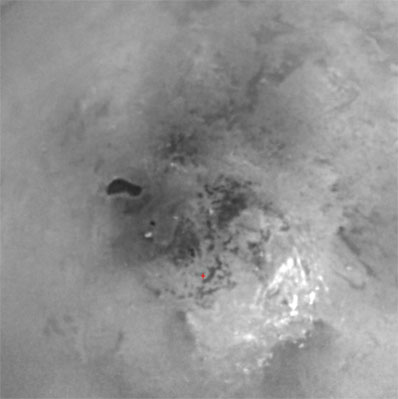
On the image above, taken by the Cassini spacecraft, a large dark patch contrasting with the bright area around it is clearly visible in the middle of the image as well as cloud formations in the lower right.
- To get further information on that news, go to: http://www.spaceflightnow.com/cassini/050628titanlake.html or http://www.astrobio.net/news/modules.php?op=modload&name=News&file=article&sid=1623&mode=thread&order=0&thold=0
June 11, 2005: New evidence for the presence of a volcano on Titan
Dr Christophe Sotin and his team, of the "Université de Nantes" ( France ) have spotted what appears to be an ice volcano or cryovolcano, roughly 30 kilometers wide ( 19 miles ). They analysed the data gathered by the Visual and Infrared Mapping Spectrometer ( VIMS ) onboard the Cassini spacecraft, during the flyby of Titan on October 26, 2004, which can peer through the "opaque" haze at infrared wavelengths.
The circular feature thought to be an icy volcano is located in the dark area where the Huygens probe landed on January 14, 2005, not so far from the landing site. It does not resemble any features seen on Saturn's other icy moons. Many elements push us into thinking that the geologic phenomenon is a dome formed by upwelling icy plumes that release a mixture of methane, water ice and ammonia onto the surface through lava flows, rapidly freezing.
One can clearly observe a round shape with elongated wings extending westward. Those wings might be the sign of lava flows. The structure resembles volcanoes on Earth and Venus, with overlapping layers of material from a series of flows. In the center of the dome, a dark spot is clearly visible. It appears to be a caldera, a bowl-shaped structure formed above chambers of molten material.
On that basis, one can postulate that methane, the second constituent of Titan's atmosphere ( around 3% of its composition ), might come from cryovolcanism that replenishes the atmosphere with methane. This hypothesis is strongly supported by Christophe Sotin since no ocean or lake of methane or ethane has been identified up to now."Interpreting this feature as a cryovolcano provides an alternative explanation for the presence of methane in Titan's atmosphere. Such an interpretation is supported by models of Titan's evolution," Sotin said.
The internal heat source engendering the rise and the eruption of cryomagma is probably due to tidal forces generated by Saturn and other satellites. Future Titan flybys will help determine whether tidal forces can produce enough heat to drive the volcano, or whether some other energy source must be present. Black channels photographed by the Huygens probe on January 14, 2005, could have been formed by erosion from liquid methane rains following the eruptions.
The circular feature lies in a region photographed by the VIMS with the highest resolution image. It covers an area 150 kilometers square ( 90 miles ). Landscape features are revealed at infrared wavelengths larger than 1.3 microns. The details of the dome are very clear at 2.75 microns and very blurred at windows such as 1 micron or 5 microns.
The visual and infrared mapping spectrometer instrument can detect 352 wavelengths of light from 0.35 to 5.1 micrometers. It measures the intensities of individual wavelengths and uses the data to infer the composition and other properties of the object that emitted the light; each chemical has a unique spectral signature that can be identified.
Cassini RADAR team member Ralph Lorenz of the University of Arizona says that the feature found by the VIMS instrument is interesting but he insists on the fact that there is no evidence that it is a source of methane. He also notes that RADAR data would be needed to confirm that the VIMS feature is volcanic. He points out:"It might well be a volcano, but it would be hard to say for sure without RADAR data." Other possible explanations, though improbable, have been advanced: it could have been a cloud but it doesn't move and it is the wrong composition. So, it is not a cloud. It could be an impact crater; but how to explain the dark spot similar to a caldera, in the center of the circular shape? The circular feature could also be an accumulation of solid particles transported by gas or liquid, similar to sand dunes on Earth. But the shape and wind patterns don't match those normally seen in sand dunes.
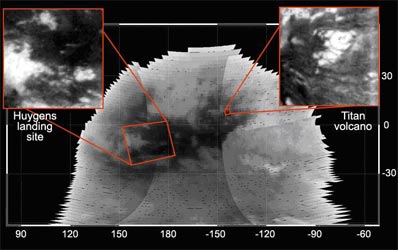
The image above captured during the Titan flyby on October 26, 2004, around 1200 kilometers from the moon represents the dark area in which the Huygens probe landed on January 14, 2005. The circular feature lies in the upper right of this dark area.
- To get further information on that news, go to http://www.spaceflightnow.com/cassini/050608titanvolcano.html or http://www.astrobio.net/news/modules.php?op=modload&name=News&file=article&sid=1595&mode=thread&order=0&thold=0
May 28, 2005: An unusual bright, red spot on Titan intrigues scientists
Titan's surface shows variations in brightness: the brighter areas were believed to be made up of ice whereas darker regions were thought to be composed of organic material such as methane or ethane. In this overview, there is an uncommon surface feature, a bright, red spot which appears to be the most reflective patch on Titan. This red spot, roughly semi- circular, is about 483 kilometers wide ( 300 miles ), lies just southeast of the bright region called Xanadu and is visible to multiple instruments on the Cassini spacecraft.
Several hypothesis have been advanced to determine the nature of this bright spot. Some scientists speculate that this region may be a "hot" spot, an area possibly warmed by a recent asteroid impact or by a mixture of water ice and ammonia from a warm interior, oozing out of an ice volcano onto colder surrounding terrain. It may also be methane geysers or volcanoes generating permanent and stationary clouds responsible for this uncommon reflectivity.
Dr. Robert H. Brown, team leader of the Cassini visual and infrared mapping spectrometer and professor at the Lunar and Planetary Laboratory, University of Arizona, Tucson, said:" At first glance, I thought the feature looked strange, almost out of place...After thinking a bit, I speculated that it was a hot spot. In retrospect, that might not be the best hypothesis. But the spot is no less intriguing."
Dr. Alfred S. McEwen, Cassini imaging team scientist, also of the University of Arizona pointed out:" This bright patch may be due to an impact event, landslide, cryovolcanism or atmospheric processes. Its distinct color and brightness suggest that it may have formed relatively recently."
Dr. Elizabeth Turtle, Cassini imaging team associate, from the Lunar and Planetary Laboratory said:" It's possible that the visual and infrared spectrometer ( VIMS ) is seeing a cloud that is topographically controlled by something on the surface, and that this weird, semi-circular feature is causing this cloud."
Jason Barnes, a postdoctoral researcher working with the visual and infrared mapping spectrometer team at the University of Arizona said:" If the spot is a cloud, then its longevity and stability imply that it is controlled by the surface. Such a cloud might result from airflow across low mountains or outgassing caused by geologic activity." He added:" Titan's surface seems to be mostly dirty ice. The bright spot might be a region with different surface composition, or maybe a thin surface deposit of non-icy material."
Another possibility is that this bright, red patch might be mountains. But they'd have to be much higher than the 100-meter high ( 300-foot ) hills Cassini's radar altimeter has seen so far. However, scientists doubt that Titan's crust could support such high mountains.
Mountains, plateaus, a permanent cloud formation generated by geysers or cryovolcanoes, impact crater, an exotic organic material. Planetologists put forward many hypothesis but, for the moment, there is a lack of clues and no solid argument.
The VIMS team will be able to test the hot spot hypothesis on the July 2, 2006, Titan flyby, when they take nighttime images of the same region. If the spot glows at night, researchers will know it's hot.
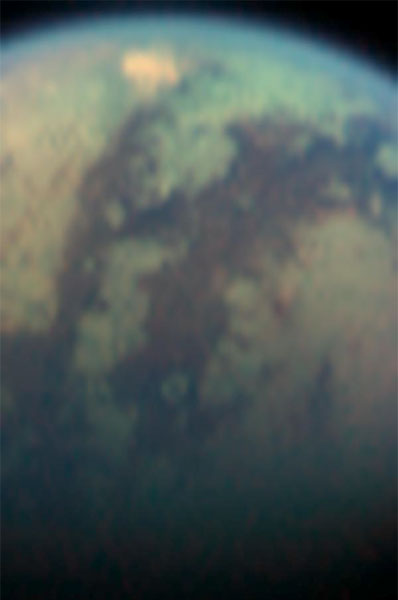
- To get further information on that news, go to: http://www.spaceflightnow.com/cassini/050525titanspot.html
May 21, 2005: Titan's atmosphere reveals some similarities with Earth's atmosphere
From outerspace, the atmosphere of Titan appears very different from Earth's atmosphere. This gas layer is orange, completely opaque and very deep. Yet, it is primarily composed of nitrogen like Earth's atmosphere.Hence, molecular nitrogen represents around 96% of the gas composition on this moon compared to 78% on planet Earth.
But what makes Titan's atmosphere unique is the presence of a large amount of organic molecules such as methane, ethane, acetylene or even octane. And the organic chemistry that occurs in Titan's atmosphere is an analog of the processes that may have been present in the early terrestrial atmosphere.
Another main constituent of Titan's atmosphere is argon.We still don't know if the abundance of argon exceeds that of methane. Data from the European Space Agency's Huygens probe, which parachuted through the atmosphere on 14 January 2005 should bring us the means to answer this question.
Contrary to Earth's atmosphere, the atmosphere of Titan doesn't contain any significant amount of oxygen.
Edward Wishnow of Lawrence Livermore National Laboratory who participated in the research by measuring the spectrum of methane in the laboratory at temperatures and densities similar to Titan's ( about 113 Kelvin, -256°F or -160°F and about one atmosphere pressure ) pointed out:"Titan's spectrum shows sharp emission lines that arise due to methane in the stratosphere that is warmer than the underlying denser atmospheric layers."
Titan's meteorology begins to be unveiled: there is no water cycle on Titan, given the low temperatures ( -179°C, -290°F or 94K ), rather a methane cycle. Very few clouds have been spotted up to date. It seems that clouds are largely scarcer than on Earth. However, as said Sushil Altreya, a professor and director of the Planetary Science Laboratory in the University of Michigan College of Engineering, several elements argue for methane rain on Titan: river channels, the "wet clay" like surface concluded by the Surface Science Package, the sudden change in the methane mixing ratio at 17-19 km altitude detected by the Huygens Gas Chromatograph Mass Spectrometer ( GCMS ) during the descent on 14 January 2005 that might indicate a thick cloud or haze layer of methane, the methane mixing ratio which steadily rose below this 17-19 km altitude and also the surge in the methane mixing ratio which was recorded during the landing of the probe, implying a reservoir of liquid methane on the surface.
CIRS principal investigator F.Michael Flasar of NASA / Goddard Space Flight Center said:"The CIRS ( Composite Infrared Spectrometer ) observations of Titan's stratosphere indicate that its winter ( northern ) pole has many properties in common with Earth's: cold temperatures, strong circumpolar winds and anomalous concentrations of several compounds ( on Titan, organic molecules ) that are reminiscent of conditions within the winter polar regions on Earth, the so-called ozone holes. In both cases, the essential ingredient is the strong winds, which isolate the polar air and inhibit mixing with that at lower latitudes."
- To get further information on that news, go to: http://www.astrobio.net/news/modules.php?op=modload&name=News&file=article&sid=1564&mode=thread&order=0&thold=0 or http://www.llnl.gov
May 3, 2005: Large quantities of complex carbon-based compounds identified in the upper atmosphere of Titan
The Cassini's sixth flyby of Titan, the closest ever, on April 16, allowed a major breakthrough in the study of its enigmatic atmosphere. The Cassini spacecraft came within 1,027 kilometers ( 638 miles ) of the satellite and spotted a large amount of complex hydrocarbons.
The device that made this finding possible is the Cassini's ion and neutral mass spectrometer ( INMS ). It detects charged and neutral particles in the atmosphere. The information gathered will enable scientists to better understand the structure, dynamics and history of this hazy and opaque atmosphere.
Complex mixtures of hydrocarbons and carbon-nitrogen compounds ( nitriles such as HCN ) were observed throughout the range of masses measured by the Cassini ion and neutral mass spectrometer instrument.The finding defies the theories according to which methane concentrations derive from the soil or the crust of Titan, via cryovolcanism notably.
Dr Hunter Waite, principal investigator of the Cassini ion and neutral mass spectrometer and professor at the University of Michigan, Ann Arbor, pointed out:"We are beginning to appreciate the role of the upper atmosphere in the complex carbon cycle that occurs on Titan...Ultimately, this information from the Saturn system will help us determine the origins of organic matter within the entire solar system."
The concentration of methane and other hydrocarbons was believed to increase progressively as we go down towards the surface. That's what the Huygens probe revealed during its descent on January 14.This idea must be revised: hydrocarbons containing as many as seven carbon atoms as well as nitrogen-containing hydrocarbons ( nitriles ) were spotted in the upper atmosphere.
Complex hydrocarbons ( ethane, acetylene, ethylene, propane, polymers...) form under the action of ultraviolet light or energetic particles from Saturn's magnetosphere. But no one expected to find this plethora of complex hydrocarbon molecules in the upper atmosphere. It should condense and rain down to the surface.
Hunter Waite added:"Biology on Earth is the primary source of organic production we are familiar with but the key question is: what is the ultimate source of the organics in the solar system?".
Thanks to this finding, new scientific approaches appear regarding the question of the origin of life.There is a consensus, universally shared, that carbon-based life started to develop in the most common solvent, that is to say liquid water.However, the presence of complex hydrocarbon compounds in the outer layer of Titan's atmosphere push us into advancing the idea that the simplest lifeforms, that would lead to the ecosystem we know, might have started to develop in the upper atmosphere of the Earth, generated under the action of ultraviolet light.
The alien world of Titan is as fascinating as intriguing. It is a natural laboratory to study organic chemistry in an atmosphere very similar to the atmosphere of planet Earth in terms of composition.The atmosphere of Titan might even be identical to the prebiotic atmosphere of the Earth, billions of years ago.
The american astrophysicist Carl Sagan evoked the possibility of life in the atmosphere of Jupiter and some scientists have recently speculated that the Venusian atmosphere might be a place where a microbial life can emerge and develop.In the case of Titan, we have one certainty: a complex organic chemistry is occuring in the upper atmosphere under the action of sunlight ( ultraviolet radiations...).
- To get further information on that news, go to: http://www.spaceflightnow.com/cassini/050425titan.html
March 26, 2005: An ammonia rich subsurface ocean, source of Titan's atmosphere ?
Titan harbors a fascinating atmosphere that draws the attention of numerous scientists.This exotic atmosphere is, to a certain extent, unique: the gas layer appears orange from outerspace; it is very deep extending up to 730 km above the surface, very thick ( 4 times denser than on Earth at "sea level") with a surface pressure close to 1.5 bars and completely opaque from outerspace in visible light.Nevertheless, the Titan atmosphere shares some major commonalities with the atmosphere of the Earth: it is mostly composed of molecular nitrogen.
A major subject about this weird atmosphere is the question concerning its origin.On that ground, the data gathered by the Huygens probe and the Cassini spacecraft allowed the development of new hypothesis and theories.Jonathan I Lunine, a professor of planetary science and physics at the University of Arizona's Lunar and Planetary Laboratory in Tucson, Arizona and one of the key players on the Cassini Huygens mission puts forward a strong hypothesis involving ammonia in the emergence and evolution of the atmosphere.
Jonathan I Lunine was already famous for a theory predicting the possibility of a complex meteorological cycle governed by key hydrocabon molecules such as methane and ethane and producing lakes and seas of hydrocarbon molecules progressively enriched with ethane.
The latest results from the Cassini Huygens mission don't eliminate this approach.Numerous fluvial features were observed during the descent of the Huygens probe and a dark and flat area suggested the presence of a very wet surface.But was it linked to methane or ammonia ? Up to now, no one really knows.
Jonathan I.Lunine points out:"I think what's clear from the data is that Titan has accreted or acquired significant amounts of ammonia, as well as water...If ammonia is present, it may be responsible for resurfacing significant parts of Titan."
The Titan data revealed what might be a relatively young surface.Very few impact craters were spotted.Jonathan I Lunine adds:" That means Titan's craters are either obliterated by resurfacing, or they are being buried by organics."He argues:" It's exciting to see a remnant of an impact basin.Big impact craters on Earth are nice places for getting hydrothermal systems.Maybe Titan has a kind of analogous methanothermal system."
Titan is believed to be differenciated because of its size.It's likely that Titan has a rock core, surrounded by an overlying layer of rock-hard water ice.Jonathan I Lunine advances the possibility of a liquid ammonia-and-water layer beneath its hard presumably water-ice surface.
Several elements are consistent with the configuration of a subsurface ocean comprising a mixture of water and ammonia.
The first element is what appears to be cryovolcanism.The radar data and the panoramic images taken by the Huygens probe showed narrow drainage channels running from brighter highlands to lower, flatter dark areas.Was it related to rains of hydrocarbon molecules ( methane, ethane...) or was it linked to a Titanian volcanism? Cassini radar has likely already seen places where liquid ammonia and water slurry erupted from extremely cold volcanoes and flowed across Titan's landscape.In this case, ammonia would be a major source for the molecular nitrogen, present in the Titan's atmosphere.
Second, Titan's eccentric, rather than circular, orbit around Saturn can be explained by the moon's underground liquid layer, as suggests Lunine.
Third, Cassini's Ion Neutral Mass Spectrometer and Huygens's Gas Chromatograph Mass Spectrometer (GCMS) which sampled Titan's atmosphere didn't detect the non-radiogenic form of argon, as pointed out Tobias Owen of the University of Hawaii, a Cassini interdisciplinary scientist and member of the GCMS science team.That suggests that the building blocks, or "planetesimals", that formed Titan contained nitrogen mostly in the form of ammonia.
At the end of the day, the data released raise new questions and hypothesis: we know, now, that an exotic volcanism is probably at play on Titan due to apparent traces of volcanic fluid and grooves or rivers.But we don't know for sure the nature of the fluids.If it is related to volcanoes, it can be an ammonia rich substance.In that configuration, one can postulate that the molecular nitrogen of the atmosphere derives, in large proportions, from cryovolcanism.If the fluids are linked to meteorology, it's rather made up of hydrocarbon molecules such as methane or ethane.
And since we associate methane and life on Earth, we can't help asking the following question: how far has organic chemistry progressed on Titan's surface ?
- To get further information on that news, go to: http://www.spaceflightnow.com/news/n0502/21titan/
February 19, 2005: Cassini's radar spots a giant crater and what resembles sand dunes
A giant impact crater the size of Iowa was identified on Saturn's moon Titan by NASA's Cassini radar instrument during the third close flyby on February 15, 2005.
Cassini flew within 1,577 kilometers ( 980 miles ) of Titan's surface and its radar instrument took detailed images of the surface.It's only the second time the radar instrument has examined Titan.Scientists see some things that look familiar, along with scenes that are completely new.The first radar image taken during the first close flyby revealed notably some kind of fractures and no clear impact crater.The latest radar image brings new elements.
"It's reassuring to look at two parts of Titan and see similar things",said Dr.Jonathan Lunine, Cassini interdisciplinary scientist from the University of Arizona, Tucson."At the same time, there are new and strange things."
It's the first time that Cassini's radar and the imaging camera overlapped.This overlap in coverage should be able to provide more information about the surface features than either technique alone.The 440-kilometer-wide ( 273-mile ) crater identified by the radar instrument was seen before with Cassini's imaging cameras, but not in this detail.
A second radar image reveals weird shapes nicknamed "cat scratches".These parallel linear features observed in several places remind sand dunes from the Sahara ( Africa ).One can notice that they are roughly turned toward the same direction.As a result, they may be formed by winds, some kind of fluid, or even fractures on ice surfaces.
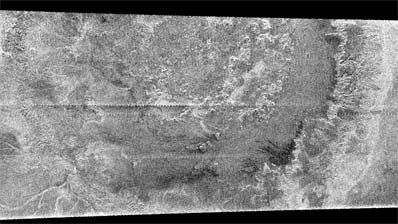
The radar image above, showing a 440 km wide crater, was taken by the Cassini spacecraft on February 15, 2005.
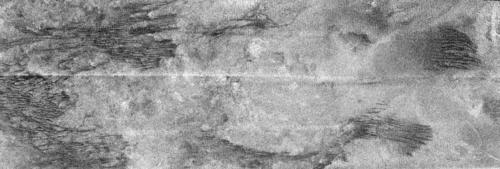
The image above is a portion of the radar image acquired by the Cassini Titan radar mapper on February.15, 2005.It measures about 300 kilometers ( 186 miles ) from top to bottom and shows an area near the north east corner of the large bright region named Xanadu.It reveals notably intriguing groups of dark linear features scattered in several spots in the landscape.
- To get further information on that news, go to: http://www.spaceflightnow.com/cassini/050216titancrater.html
February 12, 2005: New wind patterns thanks to Huygens data
A large array of radio telescopes, including major facilities of the National Science Foundation's National Radio Astronomy observatory ( NRAO ), has provided data needed to measure the speed of the winds faced by the Huygens spacecraft during its descent through the atmosphere of Titan.
The NRAO's Robert C.Byrd Green Bank Telescope (GBT) in West Virginia ( USA ), eight of the ten antennas of the Very Long Baseline Array ( VLBA ) and the CSIRO Parkes Radio Telescope in Australia were in the list of large radio antennas to try to detect and absorb the weak radio signals, the "carrier" frequency released by the Huygens probe.
The Cassini orbiter was not able to capture a large amount of data sent by the Huygens probe because of a communication error between Huygens and Cassini, precisely a configuration problem with one of Cassini's receivers.As a result, the large radio antennas on Earth focused their work on absorbing the weak signals coming from the Huygens probe.
Measurements of the frequency shift caused by the craft's motion, called Doppler shift, are giving planetary scientists their first direct information about Titan's winds.The winds are weak near the surface and increase slowly with altitude up to about 60 km, becoming much rougher higher up where significant vertical wind shear may be present.
Early analysis of the radio-telescope data shows that winds on Titan flow from west to east, in the direction of the moon's rotation, at nearly all altitudes.The highest wind speed of roughly 120 metres per second ( 430 km/h or 270 mph ) was measured about ten minutes after the start of the descent, at an altitude of about 120 km ( 75 miles ). Winds are weak near Titan's surface and increase in speed slowly up to an altitude of about 60 km ( 37 miles ), where the Huygens probe encountered highly-variable winds that scientists think indicate a region of vertical wind shear.
The ground-based Doppler measurements were carried out and processed jointly by scientists from the NASA Jet Propulsion Laboratory ( JPL,USA ), and the Joint Institute for VLBI in Europe ( JIVE, The Netherlands ) working within an international Doppler Wind Experiment team.
Currently, there is an approximately 20-minute interval with no data between the measurements at GBT and Parkes.This gap in Doppler coverage will eventually be closed by data from other radio telescopes which are presently being analysed.In addition, the entire global set of radio telescopes performed Very Long Baseline Interferometry ( VLBI ) recordings of the Huygens signal to determine the probe's precise position during the descent.
- To get further information on that subject, go to: http://www.astrobio.net/news/modules.php?op=modload&name=News&file=article&sid=1435&mode=thread&order=0&thold=0 or http://www.esa.int/esaCP/SEMA8SXEM4E_index_0.html
January 19, 2005: Astonishing geological and meteorological phenomena!
That's one small touchdown for the Huygens probe, one giant touchdown for planetologists: Titan has finally unveiled some secrets of its landscape. Many experts predicted a foggy environment preventing the Huygens lander from getting clear images of the horizon.That's not the case.The Huygens spacecraft landed in a flat area covered with eroded boulders, actually closer in size to pebbles.And surprisingly, the soil has a colour close to the colour of the atmosphere, that's to say orange, red.
Carolyn Porco, from the Cassini Imaging Team pointed out:"I totally didn't expect it, it looks like Mars!" She added:"I'm thinking it can't be silicon rocks...Because if Titan is a differentiated body, the rocky material would have fallen to the inside...So it's ice rocks."
The panoramic images of the landscape during the descent phase revealed several striking features of the region: the photos clearly show a very flat and dark area reminding oceans on Earth, an elevated terrain with a well defined shoreline, a "pleiade" of channels with ramifications on the elevated terrain opening in many parts into the ocean like area, cloud formations or fog near the ground in the flat area and along the shoreline."It's almost impossible to resist the speculation that this flat, dark material is some kind of drainage channel, that we're seeing some kind of a shoreline" said University of Arizona researcher Martin Tomasko, principal investigator with the descent imager team."We don't know if this still has liquid in it or whether the liquid has drained away or drained into the surface."
Concerning the "fluvial patterns", Carolyn Porco advance the hypothesis of a cryovolcanic source."I suppose lava tubes could do this.If there were vulcanism you could get lava tubes because you see meandering things like this on the moon, and they are not depressions, they are more raised tubes.In fact you see this even in Hawaii, where you can see collapsed lava tubes. There was a big vacant tube and then it just collapsed. That's because the stuff on the outside cools faster than the stuff on the inside, so the stuff on the inside keeps flowing until there is no more, but the stuff on the outside forms a crust.That's called a lava tube."
The amount of data gathered by the Huygens probe is so huge that it will take years to scientifically digest it.Around 350 images have been taken.The exotic meteorology of Titan is going to be deeply analysed thanks to the huge amount of data captured by the spacecraft during its descent through the atmosphere from an altitude of about 1250 km. Huygens sampled the atmosphere as it floated toward the surface in winds measured at about 16 mph ( 26 km/h) between six miles( 10 km ) and 12 miles altitude ( 20 km ).On-board instruments detected a thick methane haze, or cloud deck, 11 to 12 miles above the ground where atmospheric pressure measured about 7.3 pounds per square inch.
The outside temperature when the descent began was 70.5 Kelvin, that is minus 202.6 degrees Celsius or minus 332.8 degrees Fahrenheit, while the temperature on the surface was slightly warmer: 93.8 Kelvin, that is minus 179.4 degrees Celsius or minus 290.8 degrees Fahrenheit.This temperature is sufficiently low to allow the presence of liquid methane. We didn't clearly identify any ocean of methane or other hydrocarbon compounds.Nevertheless, it's likely that pools of methane are present in some places, notably on the flat and dark area. And a sign of those lakes might be those large cloud blankets near the ground located in this large flat area.
Clearly, the Titan meteorology is complex.It is closely linked to the obliquity of the moon ( 26 degrees ), to its distance to the Sun and to its position around Saturn. We can also postulate that the climate is different in the hemisphere permanently facing the Sun and in the "external hemisphere".We know now that the south pole, currently in the summer period, is covered with large cloud formations.Perhaps that the data gathered by the Huygens spacecraft will help us figure out what is going on in this area. In any case, Titan is a "fantastic laboratory" to try to understand the origin of methane, its chemistry and eventually the way it could lead to the development of any lifeform.
The composite image below confronts two different landscapes: the small photo was taken by the Huygens probe as it descended through the Titan atmosphere around 8 km above the surface: the shoreline reminds a terrestrial shoreline.The big photo represents the seaside of the French Riviera.
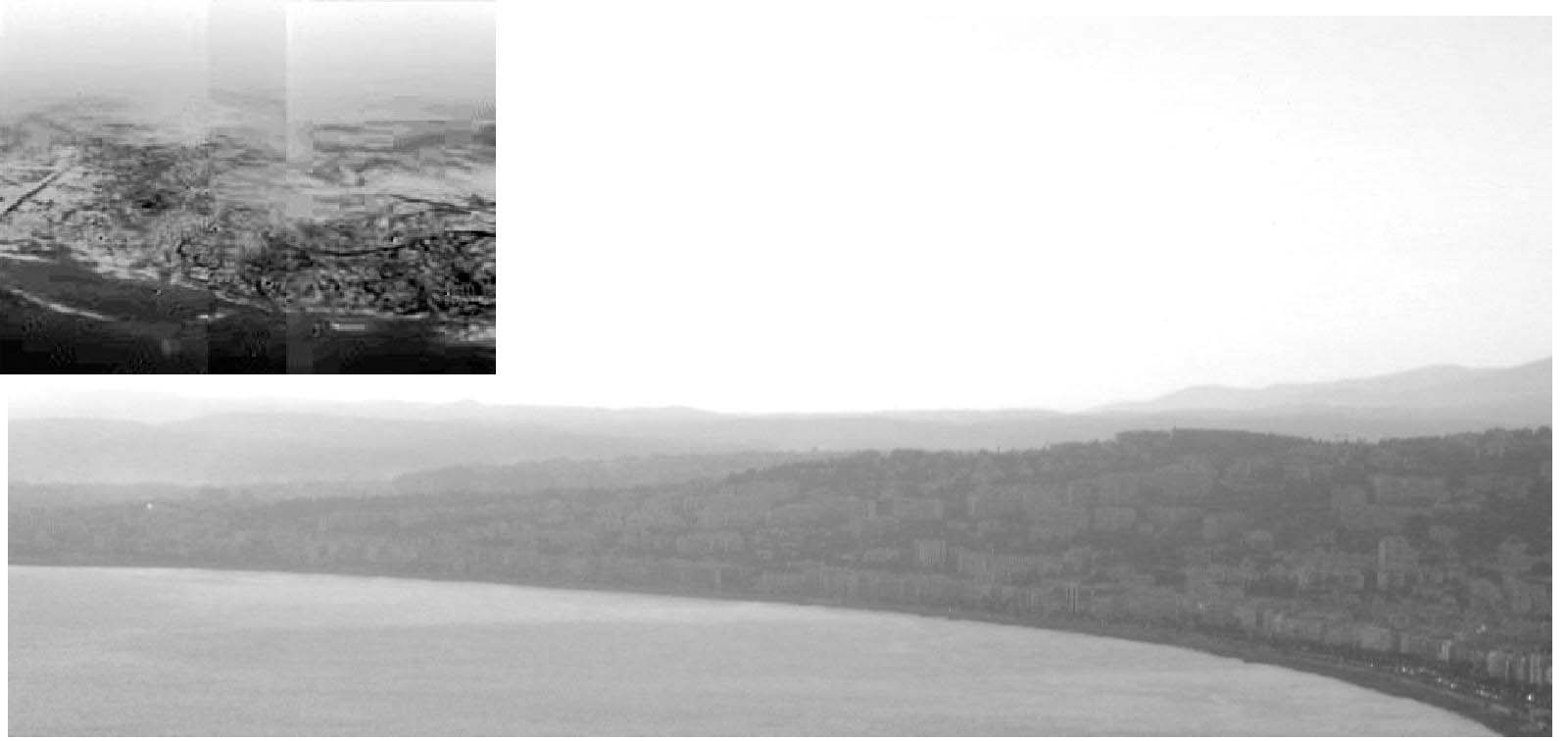
- To get further information on the latest news from Titan, go to: http://www.astrobio.net/news/print.php?sid=1394 or http://www.spaceflightnow.com/cassini/050115science.html
January 14, 2005: Towards a new age for planetology!
The first panoramic image of Titan has just been released and it's an immense surprise not only for scientists but also for the world community.The first striking characteristic of the surface is the presence of river like features with ramifications.Those channels may hold a mysterious fluid since the surface temperature is too low to allow liquid water.Until now, the consensus for the surface temperature was -180°c (-292°F or 93 Kelvin).As a result, the enigmatic fluid might be methane, ethane or a hydrocarbon rich mixture.But we won't go beyond the imagination of chemists and planetologists on that point.
Those kinds of grooves had been observed on the first radar image of Titan.It led scientists to postulate that an active surface was at play: was it the sign of an underground ocean? was it the sign of lava flows? or the sign of rivers?Many of those "rivers" open into a flat area on the right of the image.This flat surface doesn't contain any of those rivers.And there is a well defined edge between the irregular region where there are many rivers and the flat region. This flat part of the image might consist of liquid compounds.
Very few impact craters are visible on the panoramic image.Contrary to other moons of Saturn, Titan is covered with a thick layer of gases (mostly nitrogen): it protects it from the threat of meteorites that burn out in large proportions while penetrating at high speeds into Titan's atmosphere.But other factors could also be taken into account: lava flows from hypothetical volcanoes resurfacing the landscape, geysers, rains and liquid compounds.
The image was taken around 16 km above the surface and the rare impact craters were apparently smaller in diameter than the width of the observed rivers. A clue that the flat area might be liquid is the presence of cloud formations along the border between the irregular area covered with rivers and the ocean like area. A meteorology related to this flat region must be at play.
The image below corresponds to the first panoramic image of Titan ( black and white ) taken around 16 km above the surface:
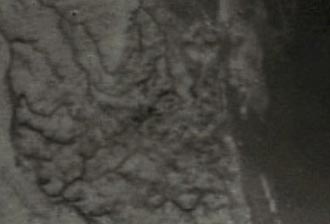
January 8, 2005: A rain of panoramic images to come!
As the huygens probe is approaching the giant moon of Saturn, Titan with a ballistic trajectory and at a speed of 14,000 miles per hour ( 22,400 km/h ) since the separation from the Cassini spacecraft on December 25, 2004, the nature of the Titan landscape remains completely unknown. But on January 14, 2005, many secrets of this alien world should be unveiled thanks to the entry of the Huygens probe into Titan's atmosphere.
If everything works as predicted, it will be the most distant touchdown any human-made object will have ever made in the solar system.
The descent of the probe should last roughly 2.5 hours during which several experiments will be led.
Martin Tomasko of the UA's Lunar and Planetary Laboratory ( LPL ) who leads the international team with the only optical instrument on the probe and eight other LPL researchers, plus their colleagues, will be at the European Space Operations Center ( ESOC ) in Darmstadt, Germany, analysing data from the Descent Imager / Spectral Radiometer ( DISR ).
DISR will study aerosol particles in Titan's atmosphere and take photographs of the surface for more than two hours as the probe spins downward. Huygens will relay data to the Cassini orbiter, which then transmits the signals to NASA's Deep Space Network. It takes 67 minutes for Cassini's signals to reach Earth.
The plunge of the probe into Titan's atmosphere has been accurately prepared: a system of alarm clocks will wake Huygens at a pre-programmed time a few hours before it slams into the outermost atmosphere, more than 800 miles ( 1270 kilometers ) above Titan's surface.
During the first three minutes inside the atmosphere, the Huygens probe must decelerate from more than 13,000 mph ( 21,000 km/h ) to 1,100 mph ( 1,800 km/h ).Temperatures on the face of Huygens' heat shield are expected to climb from 300 degrees fahrenheit below zero ( minus 150 degrees celsius ) to more than 3,000 degrees Fahrenheit ( 1,800 degrees Celsius ).
After Huygens hits the atmosphere at about 110 miles ( 180 km ) above Titan's surface, robotic controls will open a pilot parachute to pull out the 27-foot ( 8.3 meter ) main parachute at a speed of about 1,100 miles per hour ( 1,500 km/h ). Within a minute, the speed will drop to about 200 mph ( 320 km/h ).
The shell of the entry assembly module will then fall away, exposing the scientific instruments at about 100 miles ( 160 kilometers ) above the surface.The atmospheric temperature at this altitude is expected to be around minus 250 degrees Fahrenheit ( minus 120 degrees Celsius ).The Descent Imager / Spectral Radiometer ( DISR ) will begin taking images 93 miles ( 150 km ) above the surface.
At about 75 miles ( 120 km ) altitude, the spacecraft will jettison its main parachute and deploy a third, 10-foot diameter ( 3-meter-diameter ) parachute for the rest of the trek. Instruments should continue taking data for another 2 hours and 15 minutes and perhaps more.
Scientists hope that DISR will emerge from the thick Titan haze layer at about 43 miles ( 70 km ) above the surface for clear views down. The probe will hit the coldest layer of the atmosphere, the tropopause, at around 28 miles ( 45 kilometers ) where expected temperatures hover around minus 390 degrees Fahrenheit ( minus 200 degrees Celsius ).
DISR's three cameras will take about 750 images, or 250 "triplet" images, as the probe spirals toward Titan's surface. The DISR team will mosaic these images into 20 panoramic views of the ground and horizon in various resolutions.
At an altitude of 12 miles ( 20 km ), all DISR data are relayed back to the Cassini orbiter to ensure that it won't be lost on touchdown impact. At 6 miles ( 10 km ) and 3 miles ( 5 km ), DISR will take light spectra reflected from this alien surface. The team will create a spectral map to determine the color and, from that, the composition of surface features.
At two-fifths of a mile ( 700 meters ) above the surface, a 20-watt lamp on DISR will switch on and replace the colors of sunlight filtered out by Titan's atmospheric methane.
The probe has enough battery power for instruments to continue taking data for more than 30 minutes on the surface if they survive landing. Regarding the landing problem, Martin Tomasko, DISR team leader, made the following comparison: "The force of landing will be like riding your bicycle into a brick wall".The Cassini orbiter can receive Huygens ground data until it travels beyond Titan's horizon.
The DISR team expects to receive its first dataset after 8 pm ( Central European Time ) on Friday, Jan 14 and we should get a first panorama and perhaps even a simple movie during the early morning hours of Jan.15. At the same time, Martin Tomasko and others will be analysing data on atmospheric particles for their preliminary report on the atmosphere.
The DISR team will release its first results at a Jan 15 morning news conference at ESOC, where the ESA is focusing media activities.
The imaging system has a high-resolution imager, a medium resolution imager and a side viewing imager. Images from each of the three cameras are combined into a "triplet". Triplets are combined with other triplets to create mosaics, or panoramic views, of the surface.
- To get further information on this news, go to the following links: http://www.uanews.org/cgi-bin/WebObjects/UANews.woa/4/wa/SRStoryDetails?ArticleID=10311 or http://www.spacedaily.com/news/cassini-05e.html
December 16, 2004: A changing weather and giant cirrus like clouds on Titan
A new step has been taken by planetologists in their quest for the secrets of the most intriguing moon in our stellar system after the second flyby of the Cassini Huygens spacecraft on December 13, 2004. Titan is governed by a changing weather.Large cloud systems had already been spotted in the south pole, but no other clouds were visible outside this area. The second flyby enabled scientists to clearly identify giant cirrus like clouds, linear formations around 1500 km long at mid-latitudes between the equator and the south pole which were not visible in the images taken by the spacecraft on the first flyby ( October 26,2004). As a result, we have, now, the first direct evidence of changing weather patterns in the hazy atmosphere of Titan.
Dr Kevin Baines, Cassini science-team member with the visual and infrared mapping spectrometer, from NASA's Jet Propulsion Laboratory, Pasadena, California said:"We see for the first time discrete cloud features at mid-latitudes, which means we see direct evidence of weather, and we can get wind speeds and atmospheric circulation over a region we hadn't been able to measure before".
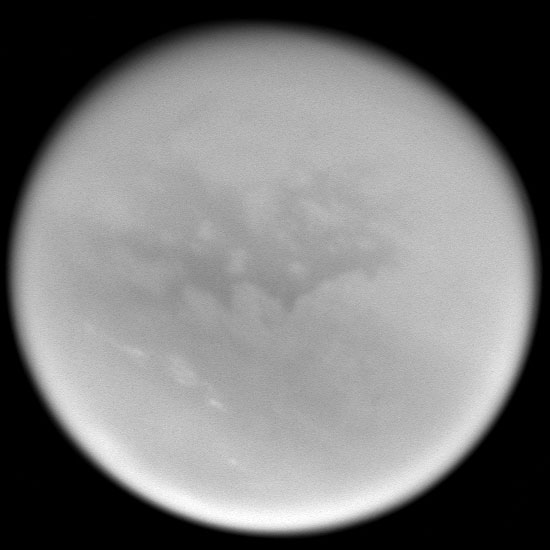
During this second close encounter, the Cassini probe captured an amazing view of Titan's night side with the glowing atmosphere. Titan's upper atmosphere is composed of a surprising number of layers of haze, extending some 400 kilometers ( 249 miles) above Titan and clearly visible in the ultraviolet image of Titan's night side limb.
The nature of the moon's surface has unveiled very few clues: it is believed to be young since we haven't been able to clearly show impact craters. Yet, several bright rings or circular features are seen in dark terrain. We used to say that dark patches were likely to harbor seas of hydrocarbon compounds or organic material: but is it consistent with the observations of what might be impact craters in those dark regions?
What can we say about the cloud formations on Titan? It is unlikely that the clouds in the south pole consist of water ice. The particles are too large ( around 5 microns in diameter). It is believed to be composed of hydrocarbon molecules or polymers. Those clouds are likely to generate storms that could be created by surface activities, like cryovolcanoes which could spew an icy mix of chemicals into the atmosphere. It could also be engendered by seasonal temperature changes similar to the model applied to our own planet.
The new phenomenon in the atmosphere of Saturn's largest moon has been discovered by a US team: the new images reveal atmospheric disturbances at Titan's temperate mid latitudes about halfway between the equator and the poles. It could be related either to short-term surface events like geysers or eruptions of cryovolcanoes or shifts in global wind patterns.
Day after day, more and more scientists become aware that a methane meteorological cycle must be at play on Titan comparable to the water-based weather cycle on Earth. Thanks to new technologies, the Cassini Huygens spacecraft is not the only tool to unveil the secrets of Titan: scientists have now at their disposal powerful ground based telescopes and notably the Gemini North and Keck2 telescopes on Mauna Kea, Hawaii, using adaptative optics thanks to which those new meteorological phenomena have been discovered.
- To get further information on this news, go to www.spaceflightnow.com or www.astrobio.net
12/09/2004: Plateaus or mountains with hydrocarbon ice on top?
Athena Coustenis of the Paris Meudon Observatory and Ralph Lorenz from the University of Arizona's Lunar and Planetary Lab display their analyses on the radar data and the Visual and Infrared Mapping Spectrometer ( VIMS) images.
The latest information on Titan have changed many ideas about Titan, notably the hypothesis of a huge ocean of hydrocarbon compounds covering the entire surface of this moon.The old approach of Jonathan Lunine datin from 1983 predicting that kind of configuration and that explains why there is so much methane gas in the atmosphere is swept.The radar and VIMS images show up that the surface is not a uniform landscape.There are bright and dark patches.Some surface features can be observed through this opaque gas layer at certain wavelenghts in the near infrared spectrum and also by using the radar instrument onboard the Cassini Spacecraft.
Regarding the analysis of these bright and dark patches on Titan, Athena Coustenis says:"I think the dark areas could be hydrocarbon lakes, because their albedo ( their reflectivity) is very low.But I don't think all the dark patches have to be hydrocarbon liquid, because water ice also is dark at infrared wavelenghts. There are also intermediate regions where the bright and dark appear mixed. That could be slush, or mud, or something solid but with material in the pores. I like the idea of a porous surface, because even if the hydrocarbon lakes are there, they cannot account for the total amount of methane in the atmosphere.In my opinion, you're going to need a subsurface reservoir. I think the bright patches are only consistent with hydrocarbon ice.They cannot be water ice, because water ice is dark in two of the wavelengths we're looking at. But hydrocarbon ice is bright in all the wavelengths.So the bright regions could be plateaus or mountains with hydrocarbon ice on top.In order to get hydrocarbon ice, you have to have a mountain ( a high elevation) and the hydrocarbon can precipitate on top of that like snow."
Ralph Lorenz insists on a technical element of the radar: "If the surface is rough, it scatters radar imaging much more effectively than a smoother surface, so bright areas tend to be rougher.And it can depend on what the surface is made of. Rock is more reflective than ice, and organic materials are darker than both of those.All these factors come into play, and so you need an educated eye to understand what you're seeing in a radar image."
The apparent limited number of impact craters suggests that the surface has been covered up, maybe by the deposition of organic materials, maybe by weather erosion, and perhaps by volcanism.Another factor to take into account is that the deep and thick atmosphere of Titan is likely to slow down, heat up and disinteger by friction any meteors that enter into the atmosphere.Concerning the few impact craters identified in the second flyby of the Cassini probe, let's keep in mind that we've only looked at 0.4 percent of Titan's surface.
Ralph Lorenz notes:" A couple of the features we've seen in our radar image seem to be indicative of volcanism. Now, volcanism on Titan would be what we call cryovolcanism, or volcanism based on ice. We think Titan is mostly made of ice and rock, roughly in proportions of 50/50. But all the rock would be at Titan's center, forming a core, and water and ice would form a crust and a mantle around that...The heat released from the radio isotopes in the rocks has to get out from Titan's interior.It can do that by just being conducted through material, or by the material moving in convective currents, similar to those that help move the continents around on Earth, or the bubbling that you see in a pan of water on the stove."
How complex is the organic chemistry on Titan? The photochemistry on Titan, resulting, notably from the action of ultraviolet light on gas molecules, engenders lots of organic compounds: 20 molecules have been identified already especially hydrocarbons ( compounds containing carbon and hydrogen ) and nitriles ( compounds with carbon, hydrogen, and nitrogen). If those molecules interact with liquid water, you very quickly ( a few hours) form a lot of oxygen bearing compounds like amino acids. Athena Coustenis specifies:"We have hydrogen cyanide (HCN) on Titan, and we know HCN is one of the building blocks that leads to molecules like amino acids."But can we find there nitriles that are even more complicated in this cold world receiving one-hundredth of the sunlight that reaches the Earth and where chemical reactions are at a very low point?And finally, is the chemistry occuring on Titan the prebiotic chemistry that led to life on Earth?On that matter, the attention will be focused on the CIRS instrument aboard the Cassini spacecraft capable of detecting large molecules.
- To get further information on the interview of Ralph Lorenz and Athena Coustenis, go to www.spacedaily.com and www.astrobio.net
11/09/2004: A flow-like feature on the latest radar image of Titan!
The radar image taken on 26th October 2004 represents roughly one percent of Titan's surface. It was centered at about 45 degrees north, 30 degrees west when it mapped the 90 square mile ( 230 square kilometer ) area shown in the new radar image.
And the specialists from the Cassini Radar Team focused their attention to a landscape feature that might be the sign of cryovolcanism and lava flows. Cassini Radar Team member Ralph Lorenz of the University of Arizona claimed:" It may be something that flowed ... Or it could be something carved by erosion. It's too early to say. But it looks very much like it's something that oozed across the surface. It may be some sort of cryovolcanic flow, an analog to volcanism on Earth that is not molten rock but, at Titan's very cold temperatures, molten ice."
Ralph Lorenz and Jonathan Lunine, interdisciplinary scientist of the University of Arizona agree to say that Titan's surface seems to be poorly cratered and as a result, they conclude that Titan's surface is young. It's been shaped by dynamic geologic processing. Jonathan Lunine also said:" Radar has provided the first evidence for possible young cryovolcanism on Titan's surface. Now, our challenge is to find out what is flowing, how it works, and the implications for Titan's evolution."
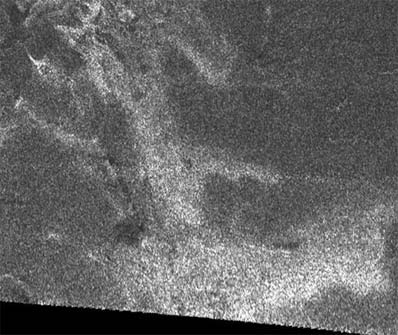
On the radar image above taken on 26th Ocober 2004, one can distinguish dark regions which may represent areas that are smooth, made of radar-absorbing materials or areas which are sloped away from the direction of illumination. Brighter regions may represent hard surfaces with higher albedo, perhaps an icy surface with snow for instance. A striking lobate bright feature stretches from upper left to lower right across the image, with connected arms to the east: would it be the sign of cryovolcanism and cryolava flows?
- More on that subject at : www.spaceflightnow.com
11/05/2004: Which scenario for the Huygens' landing on Titan?
After the closest flyby ever by the Cassini Huygens spacecraft on 26th October 2004, we still have no certainty upon the nature of the Titan soil: the Huygens probe may well land on a hard, soft or liquid surface on 14th January 2005. The analysis on the VIMS ( Visual and Infrared Mapping Spectrometer ) and radar data gathered in the latest Titan encounter are pursuing, accompanied by interesting and intriguing commentaries from the scientists of the mission.
Mark Leese of the Open University, Programme Manager for Science Surface Package ( SSP ) instruments that will unravel the mysteries of Titan said: "It's interesting that all of the possible landing scenarios that we envisaged ( a hard crunch onto ice, a softer squelch into solid organics or a splash down on a liquid hydrocarbon lake ) still seem to exist on Titan."He added:" A first look at the measurements of Titan's atmosphere during the flyby suggest that the Atmosphere Model we developed and used to design the Huygens probe is valid and all looks good for the probe release on Christmas day and descent to the surface on 14th January 2005."
The analysis of Titan's upper atmosphere, the thermosphere, has notably revealed a strange brew as Dr Ingo Mueller-Wodarg of Imperial College London noted:" Our instrument, the Ion Neutral Mass Spectrometer ( INMS ), made in-situ measurements of atmospheric gases in Titan's upper atmosphere and found a potent cocktail of nitrogen and methane, stirred up with signatures of hydrogen and other hydrocarbons. We are now working on a Weather Report for the Huygens landing in January."
Regarding the surface characteristics of Titan, Professor John Zarnecki of the Open University, lead scientist for the Huygens SSP said:" The recent results from the flyby have started to show us a very diverse and complicated surface. Titan is geologically active but hasn't yet given up all its secrets."
Professor Carl Murray, of the Imaging Science System ( ISS ) team from Queen Mary, University of London and one of our greatest specialists on Mars exploration also brought his feeling about the surface features:" The images of the Huygens' landing site returned by the cameras show a diverse range of features. We see bright and dark areas roughly aligned in an east-west direction ... These are similar to wind streaks seen on Mars and may indicate that material on Titan has been deposited by the effects of wind blowing across the landscape."
Professor Michele Dougherty from Imperial College, lead scientist on the Cassini Magnetometer, which is studying the interaction between the plasma in Saturn's magnetosphere and the atmosphere and ionosphere of Titan pointed out:" We have been able to model the Magnetometer data very well from the Titan flyby. There does not seem to be an internal magnetic field at Titan from the observations we obtained during this flyby, but we will have a much better idea about this when we have a further flyby in December which is on a very similar trajectory ... All we can say at this point is that if there is a magnetic field generated in the interior of Titan, then it is very small."
Dr Andrew Coates from University College London's Mullard Space Science Laboratory, a Co-Investigator on the Cassini Electron Spectrometer team, said : " We received some remarkable new information about Titan's plasma environment within the context of Saturn's fascinating magnetosphere. Unexpectedly, it looks like we can directly use features of the electron results to understand what Titan's upper atmosphere is made of, supplementing the ion measurements from companion sensors on other instruments ... Our electron results contain tell-tale fingerprints of photoelectrons and Auger electrons which we will use for this ... Also, the total picture shows how important electrons, raining down on Titan's upper atmosphere, are in helping the feeble sunlight drive the complex chemistry in Titan's upper atmosphere."
INMS Team Leader Hunter Waite reported that the analysis of Titan's upper atmosphere has not only confirmed the presence of nitrogen and methane. More complex hydrocarbon molecules were also detected including benzene ( C6H6 ), diacetylene ( C4H2 ), and propyne ( C3 H4 ). Those molecules are assumed to form from the action of ultraviolet rays on methane. But how to explain that those relatively heavy compounds evolve in the upper atmosphere? They should sink toward the lower atmosphere because of their weight. Hunter Waite added:" Titan seems to be mixed all the way to the top. The fact that we saw these molecules at 1200 kilometers is quite surprising ... The detection bodes well for the mission ... At lower altitudes, we expect to do even better."
By examining the proportion of two isotopes of nitrogen, nitrogen-15 and nitrogen-14 in the atmosphere, the INMS concluded that their measurements indicate that up to three-fourths of Titan's atmosphere may have been lost over geologic time. This statement results from the following reasoning: molecules of gas are often lost from the top of a planet's atmosphere under the influence of the solar wind; and in this process, a planet is more likely to lose a lighter weight molecule than a heavier weight molecule. So the more gas an atmospher loses, the more enriched it should be in heavier isotopes that is elements with more neutrons.
Hunter Waite also reported that his team didn't identify carbon nitrogen compounds known as nitriles ( HCN...) that are also known to form in Titan's atmosphere. These compounds are the building blocks of amino acids." Benzene and acetylene were easy to spot ", Waite explained. But common nitriles, such as hydrogen cyanide ( HCN ) have masses more similar to nitrogen or methane, making them harder to pick out of the INMS results with only one night's study.
- To get further information on this topic, visit the following web addresses: www.planetary.org and www.spacedaily.com
10/29/2004: The possibility of an underground ocean on Titan?
We were waiting for the analysis of the radar images of the surface of Titan, acquired on October 26,2004 when the Cassini spacecraft flew approximately 1,600 kilometers above the surface and acquired radar data for the first time. Today, the flow of radar data is coming. The images taken by the Visual and Infrared Mapping Spectrometer ( VIMS ) aboard the Cassini probe enabled scientists to identify variations in brightness on the surface of Titan and they finally assumed that brighter areas may correspond to rougher terrains while darker areas may be smoother. However, they also said that the contrasts were quite weak, hard to interpret and that they could be related to changes in the relief and not to a difference in the composition of the Titan soil. That's why they were eager to get the radar images. And the reactions to this new flow of data are intriguing: on the basis of the radar image below ( left part ), Dr Dennis Matson, project scientist for the Cassini-Huygens mission at NASA's Jet Propulsion Laboratory, Pasadena, California said: " Titan has incredible diversity...We are glad that we have a full complement of instruments on this spacecraft because it is going to take all of them to reveal the story of Titan."
We were expecting numerous impacts of meteors but only a few circular features can be seen and none can be definitively identified as impact craters. What to conclude? that there is a continuous resurfacing and erosion process on the Titan surface? Many questions deserve to be put ahead: is there a tectonic and volcanic activity on Titan? And what about tidal forces?
Dr Carolyn Porco, team leader for the imaging team, Space Science Institute, Boulder, Colorado said:" We are seeing features and patterns on the surface, and there are processes creating these patterns, and that gives us something to chew on for a while. We can't figure out what the features are, but they are intriguing.This is an environment we haver never seen before. It is a very different place and it will take some time to unravel and piece it all together."
A wide angle image of this moon shows up streaks of surface material in the equatorial region of Titan.These streaks occur in the east-west direction and may be caused by the movement of a fluid over the surface, such as wind, hydrocarbon liquids, or a migrating ice sheet, such as a glacier. The large-scale streaks are most easily explained by winds in Titan's massive atmosphere.
On the radar image below ( left part of the image), taken on October 26. 2004, striking features can be seen: there are thin bright lines reminding us grooves, rivers or a kind of fracture in the landscape as if tectonic sheets were broken. Inevitably, we are tempted to make a comparison with the jovian moon Europa which offers a satellite view of a flat, icy and broken landscape, perhaps moving on a liquid ocean. If those thin sinuous lines observed on Titan are fractures, could it be the sign of a ground sheet floating on a large ocean? Many scientists are currently speculating that there could be strong tidal forces on Titan comparable to the ones encountered on Io. If that is the case, one could postulate that any fracture on the ( probable ) icy crust of Titan could result from strong movements of an underground ocean, undergoing the tidal forces of Saturn, Rhea, Tethys, Dione, Iapetus and the other saturnian satellites.
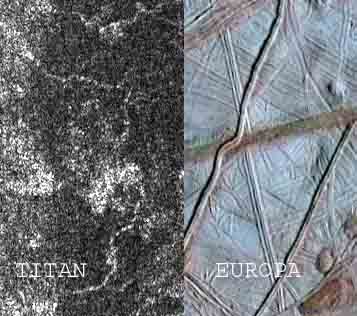
The left part of the image represents a radar image of Titan taken by the Cassini spacecraft on October.26 2004 and the right part represents a satellite view of the galilean moon Europa.
- To get further information on the radar image, go to: www.spacedaily.com
10/28/2004: Clouds of polymer vapour in the south pole of Titan?
Currently, it is summer in the southern hemisphere of Titan and it is winter in the northern hemisphere. All that is due to an inclination of its rotation axis by 26 degrees to the ecliptic plane. As a result, the south pole is currently pointed toward the Sun so that it is receiving the greatest amount of heat right now.
Under those circumstances, a huge cloud formation over the moon's south pole, spanning 1000 kilometers at its widest is evolving. And it fits the models perfectly; scientists expected it to be there. Nevertheless, they also expected it to be made of methane and it isn't. According to data gathered by the Cassini spacecraft, the particles that make up the cloud are too big to be methane."I don't believe it", says Chris McKay, a planetary scientist with the NASA Ames Research Center in Moffett Field, California. The Cassini Science Team has not yet had time to fully analyse the data sent back by the spacecraft, so they don't know what the clouds are made of.
Many ideas or theories, not always based on scientific data, are coming. Chris McKay speculates it might be ethane. But ethane, he says, is a photochemical product that is produced in the upper atmosphere and rains downward. So it wouldn't make sense that a massive ethane cloud would appear at the south pole. Another possibility, he says, is that "it's some sort of organic goo. It could be some sort of organic polymer, essentially plastic particles. Maybe little polystyrene foam balls. Who knows? " But, as with ethane, these would form from above. There's no known reason why a massive cloud of them should form at Titan's south pole."
Perhaps is there some process which is hiding the spectral signatures of the methane. Perhaps molecules of methane rise from the ground, heated by sunlight, and "merge" with more complex hydrocarbon molecules such as ethane ( C2H6).It can also be the opposite: ethane would go up from the ground under the action of sunlight then merging with methane under the action of ultraviolet light ( breaking up molecules and reorganizing them). That is a position privileged by our team.
What is below this cloud formation? Jonathan Lunine developed a model for a methane ocean progressively enriched with ethane. If those clouds consist of ethane, we can expect a sea of ethane beneath. The chemistry in this area must be intimately linked with the environmental temperature. At -85°c ( -121°F ), liquid ethane turns into gas. Below -161°c ( -257.8°F ), methane is in its liquid form. While no scientific data is provided, it's time for speculation.
- To get further information on this striking news, go to Spacedaily: www.spacedaily.com
10/27/2004: The second flyby of Titan by the Cassini Huygens spacecraft for the closest views ever snapped of the hazy moon
On october.27, the Cassini Huygens spacecraft released the closest ever images of Titan as it passed within just 1200 km ( 750 miles) of the planet-sized satellite to give scientists their first detailed glimpse of a world that, until now, has been shrouded in mystery.Do the latest pictures reveal new characteristics of the nature of its soil? not at first sight anyway!The global view of this moon clearly shows two kinds of areas, dark areas and bright areas.The bright regions cover the largest part of the surface.Hence, a large bright desert like area has been named Xanadu.The Titan's surface still keeps all its secrets: surface features can be obtained by using a spectral filter sensitive to ultraviolet light centered at a wavelength of 938 nanometers.It's nearly an achievement that the narrow angle camera on the Cassini spacecraft was able to reveal some surface features hidden beneath a thick, opaque and deep (730 km) atmospheric layer.
The image below was taken on October 25 by the narrow angle camera onboard the Cassini Huygens spacecraft using a spectral filter sensitive to a wavelength of 938 nm; the large bright area is known as Xanadu. A brighter region in the south pole reveals cloud systems.
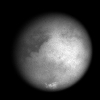
- To get the latest news on Titan, go to the Cassini imaging Team site CICLOPS: http://ciclops.lpl.arizona.edu
07/04/2004: A new evidence for cloud systems on Titan
New images taken from the Cassini Huygens spacecraft show up astonishing features of this intriguing moon. First, one clearly observes brightness variations throughout the atmosphere.Scientists used to postulate that brighter regions were likely to be the sign of carbon dioxide, ammonia or water ice while darker regions were likely to represent liquid surfaces mostly composed of methane or ethane. Since Friday the 2nd of July 2004, the theory has changed.Now, the scientific approach is slightly different: the brighter regions might indicate liquid surfaces comprising organic compounds ( based on carbon) whereas darker areas might imply solid surfaces rich of ice. Among the characteristics revealed by the Cassini Huygens spacecraft, we can emphasize striking linear forms and notably three linked dark segments (resembling the letter "H").According to Carolyn Porco, this might be the indication of a tectonic activity because of the linearity of those dark structures. It could also be the sign of mountains or plateaus.If a geologic activity on this moon is confirmed, it could have substantial consequences for the surface temperature and also for the thickness and the composition of the atmosphere.But the most fascinating news, today, is the evidence of clouds in the south pole, covering areas more than 100 km across.Until now, we knew that Titan was covered by a hazy orange layer but we didn't have any irrefutable clue for the presence of clouds in the atmosphere. Today, we have a clear indication of those phenomenon and it's good news for the odds of hydrocarbon seas on this moon.It is important, now, to specify the composition of those clouds which extend to large areas.Let's remark that Titan is the third tellurian sphere to be governed by a complex meteorology with clouds.The Titanian meteorlogy is certainly closer to the meteorology from Earth and Venus than the meteorology from Mars which doesn't imply cloud systems.
04/17/2004: Ocean waves forecast for Saturn's moon Titan, Royal Astronomical society news release ( March 31,2004). According to scientists, Titan might harbor oceans with giant waves. Dr Nadeem Ghafoor of Surrey Satellite Technology and Professor John Zarnecki of the Open University, with Drs Meric Srokecz and Peter Challenor of the Southampton Oceanography Centre, showed by computer simulation that any sea on Titan would include giant waves driven by the winds, 7 times higher than that on Earth, moving more slowly and extending much farther due to the weak gravity ( 7 times lower than on Earth).
However, it seems important to specify here that the atmospheric pressure on Titan, one and a halh times higher than on Earth, is likely to act on the waves in an opposite sense from the gravity factor. In this way, the waves rise higher than on Earth but less high than the configuration in which the atmospheric pressure is the same than on Earth.
The chance of encountering lakes or seas of liquid hydrocarbon or ammonia has been reinforced since recent radar measurements of the surface of Titan, from the giant Arecibo radio dish in Puerto Rico, have revealed a low reflectivity in most parts of the surface. Let's recall that a low radar reflectivity is observed for the liquid parts on Earth.
- click here to have access to the article in www.spaceflightnow.com